Stocks made a strong statement last week with the Dow Jones Industrials moving above the 11,000 mark decisively for the first time since June of 2001(!). The Dow flirted with 11,000 in March of last year and briefly broke thru 11,000 at the start of this year, but both times it quickly retreated back below this major resistance level. As the intraday chart below shows, this time the Dow broke thru 11K in the middle of Valentine's Day, fell back below 11K briefly 24 hours later, but has moved steadily upward since then on good volume. While that is promising, seasoned ChartWatchers will be watching for a retest of the 11K level in the coming days - that test will show if the former resistance level has turned into a support level or not.
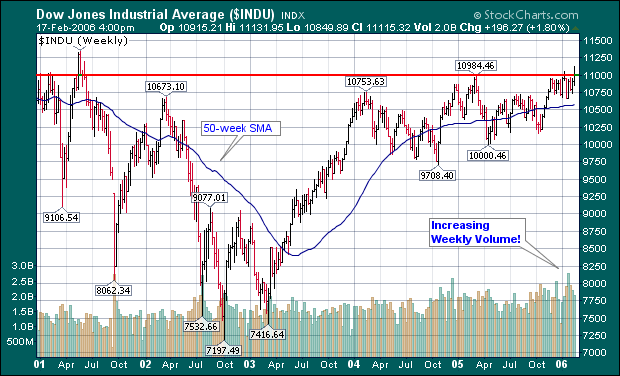
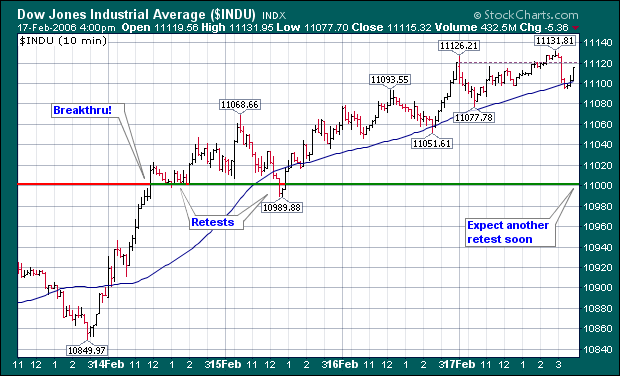
SUPER IMPORTANT ANNOUNCEMENT!
Feedback from the SharpCharts2 Beta program has been so positive that we are starting the process of converting everything on the site from using SharpCharts1 to using SharpCharts2 instead. In the coming days and weeks, you will see a gradual change in which version of SharpCharts appears as you navigate through StockCharts.com. For example, we recently added links so that you can easily get from the SharpCharts1 workbench to the SharpCharts2 workbench and back again. Soon, many of the links that take you to SharpCharts1 will automatically change so that they take you to SharpCharts2 instead (the "1-2-3" box on our homepage for example). Soon after that we will roll out a SharpCharts2 version of our Public Chart List area. And soon after that Free users will only be able to use the SharpCharts2 workbench.
After each change, we will be watching for feedback from our users on how things are going. If all of the previous changes go well, we will then take the final step and convert all of the Basic and Extra members fully over to SharpCharts2 and lift all of the current restrictions on where and how SharpCharts2 charts can be saved.
When that day comes - probably around the end of March if all goes well - SHARPCHARTS1 WILL NO LONGER EXIST! That is why it is sooooooooo important that everyone take a serious look at SharpCharts2 and tell us if there is anything that they can do in SharpCharts1 but not in SharpCharts2. NOW IS THE TIME TO TELL US ABOUT THOSE KIND OF PROBLEMS. Unfortunately, all of our users do not read this newsletter and will probably swamp our customer support team when the cutover happens. We need those of you that do read the newsletter to send us your feedback NOW, before the big crunch occurs.
Thanks again for helping us make SharpCharts2 the most powerful charting tool on the web!
The Dow was the only one of the major averages to reach a new high this week. That continues its new upside leadership that I wrote about last week. With the Dow now above the 11K level, the next potential upside target is its 2001 high at 11350. One of the big reasons for the Dow's strength was Honeywell. Last week I showed the Dow leader closing above 40 for the first time since mid 2001. It continued that bullish trend this week and appears capable of reaching 50. Another big Dow winner was Hewlett Packard. The chart below shows that Dow leader trading at nearly a five-year high. It's usually a good idea to take what the market gives us. With money starting to flow toward the Dow Industrials, stocks like Honeywell and Hewlett are where a lot of the new market leadership is coming from. Along with biotechs and telecom stocks.

Two weeks ago, I reported waning upside momentum for the Dow Industrials and Dow Transports. In addition, I noted that a Dow Theory non-confirmation was brewing, but a Dow Theory sell signal had yet to register. The Dow Industrials and Dow Transports would both have to move below their January lows for a Dow Theory sell signal.
Flash forward and both Averages recorded 52-week highs this past week. In fact, the Dow Industrials recorded a 4 1/2 year high and Dow Transports recorded an all time high. The Dow Industrials broke Diamond resistance and pushed above 110000, while the Dow Transports extended its uptrend with a move above 4400.
This is clearly a show of strength, not weakness. Upside momentum may not be as strong as it used to be, but the breakout in the Dow Industrials is bullish until proven otherwise. The move signals a continuation of the January advance and next resistance is around 11,400. Of note, the Dow Industrials was turned back at 11,400 in Apr-00, Sep-00 and May-01. This is a formidable area. The breakout at 10,900 becomes support and this is the first level to watch for signs of failure. A move below 10,900 would be negative and further weakness below the January low would be outright bearish. Should the Dow fail around 11000 and break below 10,900, a potentially bearish broadening formation would come into play (gray trendline extensions). Let’s cross that bridge when and if it gets here.
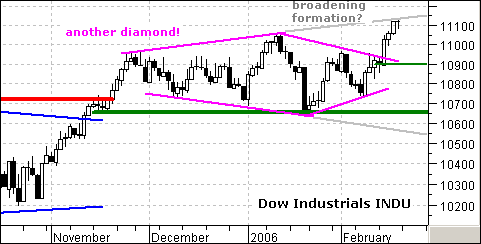
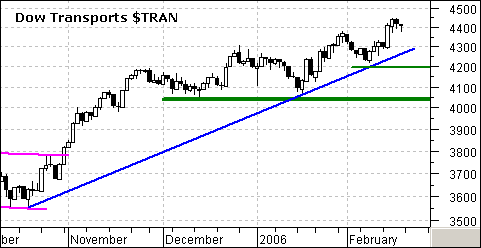
In my February 2 article I stated my belief that a medium-term correction is in progress because the PMM Percent Buy Index (PBI) has turned down and crossed down through its 32-EMA. The chart below shows this condition still exists, and I have not changed my mind at this point.
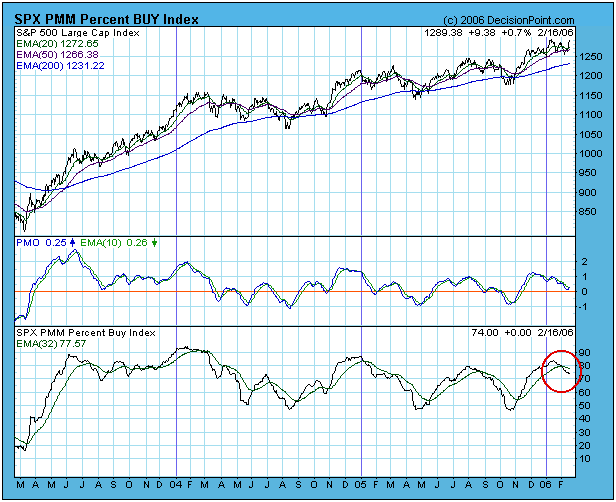
Some readers pointed out that a similar occurrence in 2003 did not have serious negative effect on prices. I agree, and I should have mentioned this in the article. There is, however, a big difference in the 2003 PBI top and those that occurred afterwards. That 2003 top occurred after a huge upward thrust of the PBI from deeply oversold levels that signaled the beginning of the bull market. The PBI has not been that deeply oversold since.
This week the market has rallied, once again challenging recent highs and straining the credibility of any bearish outlook, but in doing so it has become quite overbought in the short-term, while also approaching overhead resistance.
The overbought condition can be seen on the chart of our OBV Indicator Set* below. The Climactic Volume Indicator (CVI) has reached the top of its normal range, and the ST Volume Oscillator (STVO) is not far behind. These are short-term indicators.
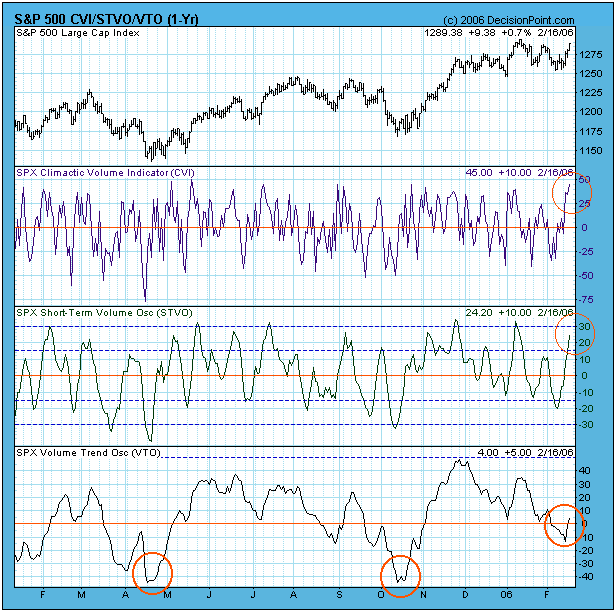
The internal problem with the rally can be seen on the Volume Trend Oscillator (VTO), which is a medium-term indicator. Note how the rallies in April and October were launched from deeply oversold levels on the VTO, whereas the current rally launched after the VTO had only dropped to neutral levels. The same problem exists on the charts of many other medium-term indicators. While the rally may continue, its pedigree is pretty weak, and indications are that it has run out of steam short-term.
For the longest time, crude oil and gold prices have dominated the news in terms of bullish commodities. We like to look at the ratio between the Integrated Oil and Gold/Silver Indexes ($XOI:$XAU) for a possible "pairs trade", and every few years we are accorded any opportunity to do so. In fact…that time is now. If we look at the ratio, we find that the 150-week moving average is a very decent "fulcrum point" from which to trade; thus we will be moving into the trade via long positions in the XOI components of Amerada Hess (AHC) and Sunoco (SUN), while moving to a short position in Freeport McMoran (FCX) and Newmont Mining (NEM).
The trade has a well defined stop loss point per a ratio trade to 7.00, where it must trade for two weeks. The target: NEW HIGHS over the next several years.
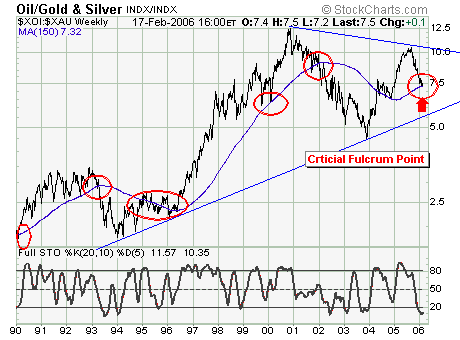
"Paid-to-Play" Portfolio 2006 YTD Performance: +13.2%
S&P 500 2006 YTD Performance: +3.1%